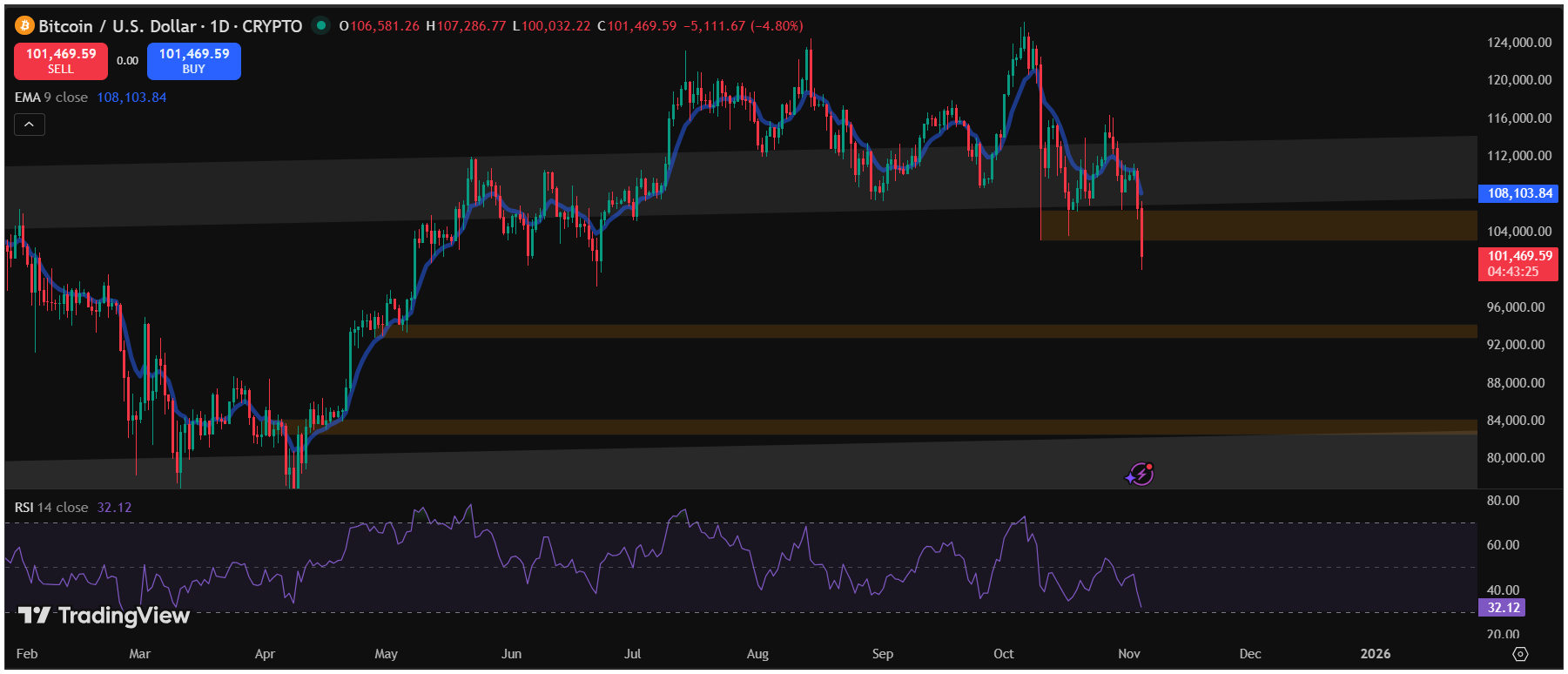Bitcoin is trading around $100,032 after many months since June 2025. It is currently tumbling from its all-time high. From a peak of roughly $1,260,230, the price has fallen about 20.75% at the time of writing.
Let’s look at five major reasons behind this drop — and what’s really happening beneath the charts and headlines.
1. Institutional Demand Weakening
One strong reason is that big investors and institutions are stepping back. Spot Bitcoin ETFs have recorded significant outflows recently. Sales from such funds mean fewer big-money buyers backing Bitcoin, which takes away a key support.
When the “big guys” reduce exposure, that creates fear among smaller investors and can trigger a cascade of selling.
2. Macro-/Monetary Policy Headwinds
Another major reason is the stance of the central banks and global economic conditions. The Federal Reserve (Fed) signalled that further rate cuts aren’t guaranteed, and the U.S. dollar is firming. That makes risky assets like Bitcoin less attractive.
Also, macro uncertainty – trade tensions, inflation concerns – adds risk-off mood to markets. When people are worried, they shift out of speculative assets.
Also Read – Circle Internet Group Monthly Outlook- November 2025 Technical Analysis
3. Technical Breakdown

On the technical side, Bitcoin is trading well below the 9 EMA across major timeframes like monthly, weekly, and daily – signaling strong bearish momentum. If selling dominance continues, Bitcoin may crash further toward the $84,000–$82,500 zone, which acts as the next major support area. In the short term, support lies around $93,000–$94,000, while resistance levels are seen near $103,000 and $106,000. The RSI on the daily timeframe is around 32, indicating an oversold zone, which aligns with the short-term support area.
4. Profit-Taking After a Big Rally
Bitcoin’s recent run up created a lot of gains for holders. With prices high and some uncertainty creeping in, many of them chose to book profits – that is sell to lock in gains. This sort of behaviour often comes after strong rallies.
When lots of people do this around the same time, it adds to downward pressure.
5. Leveraged Positions & Liquidations
Finally: there were large liquidations of leveraged positions (traders using borrowed money to bet). When price starts dropping and leveraged bets go bust, those forced sells push price down further.
This is like a domino effect: a drop triggers liquidations which trigger more drop.
Conclusion
So in short: Bitcoin’s drop is not due to one factor but a mix of weaker institutional demand, less favourable macro/monetary backdrop, chart breakdowns, profit-taking, and leveraged liquidations.
Also Read – 3 Important Differences Between Cryptography and Blockchain
This article is for informational purposes only and should not be considered financial advice. Investing in stocks, cryptocurrencies, or other assets involves risks, including the potential loss of principal. Always conduct your own research or consult a qualified financial advisor before making investment decisions. The author and publisher are not responsible for any financial losses incurred from actions based on this article. While efforts have been made to ensure accuracy, economic data and market conditions can change rapidly. The author and publisher do not guarantee the completeness or accuracy of the information and are not liable for any errors or omissions. Always verify data with primary sources before making decisions.

